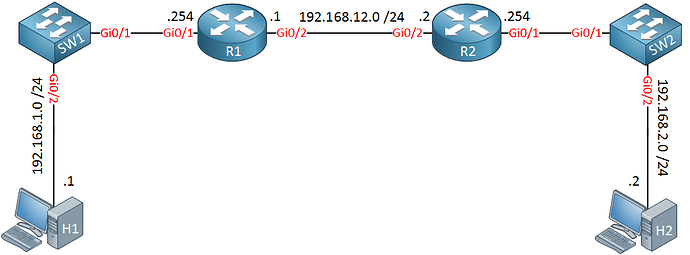Hello Shivam
If you use ping to attempt to see if a particular server (FTP, Telnet, or whatever else) is reachable, and you get “destination host unreachable” this is actually a response from a router along the path of the ping, and not from the destination host itself. For example, take a look at the same topology as that from the lesson:
Imagine that H1 is trying to ping 192.168.2.55. Note that this host does not exist in this topology. So what will happen?
- H1 will send the ping to 192.168.2.55 to the default gateway which is R1
- R1 will see that it has a routing table entry for the destination IP and will send it to R2, which is the next hop router
- R2 sees that the destination address is on a subnet directly connected to Gi0/1 so it prepares to send it out.
- It will send an ARP request for the MAC address of the host to which the 192.168.2.55 address belongs, but it will get no answer, because the host doesn’t exist.
- R2 sends an ICMP response back to the original sender (H1) with a response code of “1” which is “host unreachable”
- H1 receives the response and outputs the “host unreachable” statement.
You see here that the ICMP echo request is responded to, but not by the destination, but by a router along the path. You can also get the “destination host unreachable” response if the default gateway of H1 is not configured correctly.
The “request timed out” message will appear when no ICMP responses come from any host during an ICMP echo request.
Now on the Internet, you will find that many routers are configured not to respond to ICMP packets of any type, in order to conserve CPU and memory resources. For this reason, the most common response you’ll get when pinging on the Internet is “request timed out.” Even if a
router determines that the “destination host is unreachable” it won’t inform you in most cases.
I hope this has been helpful!
Laz
